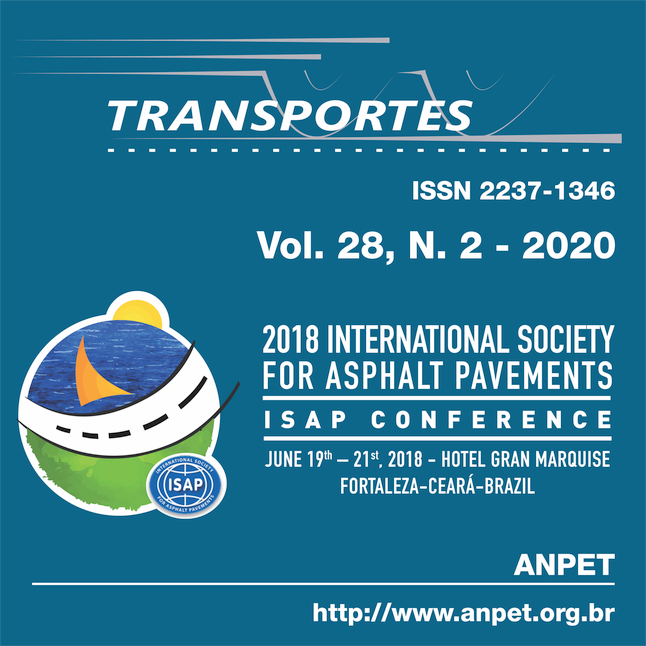Algorithm for determination of the damage characteristic (C-S) curve of asphalt mixtures
DOI:
https://doi.org/10.14295/transportes.v28i2.2163Keywords:
Asphalt Mixture, Fatigue, Viscoelastic Continuum Damage Model, C vs. S.Abstract
This paper presents the algorithm for calculating the damage characteristic curve obtained in direct tension tests taking into account sinusoidal controlled strain loading. The Viscoelastic Continuum Damage formulation is presented in a summarized form for the algorithm, in which the pseudo strain, at the instants associated to the observed stress, is calculated using the expression of the linear viscoelasticity stress under controlled strain testing. This facilitates subsequent treatment of the data to obtain the vs. curve. The proposed algorithm is simple to understand and easy to implement computationally. The algorithm was validated with the results of fatigue test simulations in three mixtures, which have indicated its potential.
Downloads
References
ALMEIDA, F. J. P (2019) Modelagem computacional de misturas asfálticas com a utilização do método dos elementos finitos, da teoria da viscoelasticidade linear e da mecânica do dano contínuo. 2019. 141 f. PhD Thesis, UFC-Brazil. http://www.repositorio.ufc.br/handle/riufc/40405 (In Portuguese language).
BABADOPULOS, L. F. A. L., FERREIRA. J. L. S., NASCIMENTO, L. A. H., SOARES, J. B., CASTELO BRANCO, V. T. F. (2016) Aging-effect incorporation into the fatigue-damage modelling of asphalt mixtures using the S-VECD Model. https://doi.org/10.1061/(ASCE)MT.1943-5533.0001676
FERRY, Y. D. (1980) Viscoelastic properties of polymers. John Wiley & Sons, Inc, New York (1980). ISBN: 978-0-471-04894-7 J. Eng. Mech-ASCE, 116 (4) (1990), pp. 751-772. https://doi.org/10.1061/(ASCE)0733-9399(1990)116:4(751)
KIM, Y. R. (2009) Modelling of asphalt concrete. ASCE Press and McGrawHill. ISBN: 9780071464628.
KIM, Y.R. and LITTLE, D. N. (1990) One-dimensional constitutive modeling of asphalt concrete. Journal of Engineering Mechanics. Volume 116. Issue 4, April 1990. https://doi.org/10.1061/(ASCE)0733-9399(1990)116:4(751)
LAMBORN, M. J. and SCHAPERY, R. A (1993) An investigation of the existence of a work potential for fiber-reinforced plastic. Journal of Composite Materials. Volume 27. Issue: 4, page(s): 352-382. Issue published: April 1, 1993. https://doi.org/10.1177%2F002199839302700402
LEMAITRE, J. (1996) A course on damage mechanics. ISBN 978-3-642-18255-6. https://doi.org/10.1007/978-3-642-18255-6
NASCIMENTO, L.A.H. (2015) Implementation and validation of the viscoelastic continuum damage theory for asphalt mixture and pavement analysis in Brazil. PhD Thesis, North Carolina State University, Raleigh, North Carolina.
PAGEN, C. A. (1965) Rheological response of bituminous concrete. In Highway Research Record 67, HRB, National Research Council, Washington, D.C., 1965, pp. 1–26.
PARK, S.W.; KIM, Y. R.; SCHAPERY, R.A. (1996) A viscoelastic continuum damage model and its application to uniaxial behavior of asphalt concrete. Mechanics of Material, V. 24, pp. 241-255. DOI: 10.1016/S0167-6636(96)00042-7
SCHAPERY, R. A. (1981) On viscoelastic deformation and failure behavior of composite materials with distributed flaws. Advances in Aerospace Structures and Materials - AD-01, ASME, New York, pp. 5-20.
SCHAPERY, R. A. (1994) Nonlinear viscoelastic constitutive equations for composite materials based on work potentials. Proceedings 12th congress of applied mechanics (ed. Kobayashi), Appl. Mech. Rev., 47. DOI: 10.1115/1.3124421
SCHAPERY, R.A. (1984) Correspondence principles and a generalized j integral for large deformation and fracture analysis of viscoelastic media. Int. J. Fracture., 25, 195-223. https://doi.org/10.1007/BF01140837
SOUZA, R. C. (2018) Avaliação do dano por fadiga em misturas asfálticas finas através de ensaios dinâmicos uniaxiais. Master Thesis. PUC-Brazil (in Portuguese language).
UNDERWOOD, B., KIM, Y., SAVADATTI, S., THIRUNAVUKKARASU, S., GUDDATI, M. (2009) Response and fatigue performance modeling of ALF pavements using 3-d finite element analysis and a simplified viscoelastic continuum damage model. In: Asphalt Paving Technology: Association of Asphalt Paving Technologists-Proceedings of the Technical Sessions. [S.l.: s.n.], 2009. v. 78, p. 829–868.
Downloads
Published
How to Cite
Issue
Section
License
Authors who submit papers for publication by TRANSPORTES agree to the following terms:
- The authors retain the copyright and grant Transportes the right of first publication of the manuscript, without any financial charge, and waive any other remuneration for its publication by ANPET.
- Upon publication by Transportes, the manuscript is automatically licensed under the Creative Commons License CC BY 4.0 license. This license permits the work to be shared with proper attribution to the authors and its original publication in this journal, and to be adapted for non-commercial purposes, provided appropriate credit is given and any derivative works are distributed under the same terms.
- Authors are authorized to enter into additional separate contracts for the non-exclusive distribution of the version of the manuscript published in this journal (e.g., publishing in an institutional repository or as a book chapter), with recognition of the initial publication in this journal, provided that such a contract does not imply an endorsement of the content of the manuscript or the new medium by ANPET.
- Authors are permitted and encouraged to publish and distribute their work online (e.g., in institutional repositories or on their personal websites) after the editorial process is complete. As Transportes provides open access to all published issues, authors are encouraged to use links to the DOI of their article in these cases.
- Authors guarantee that they have obtained the necessary authorization from their employers for the transfer of rights under this agreement, if these employers hold any copyright over the manuscript. Additionally, authors assume all responsibility for any copyright infringements by these employers, releasing ANPET and Transportes from any responsibility in this regard.
- Authors assume full responsibility for the content of the manuscript, including the necessary and appropriate authorizations for the disclosure of collected data and obtained results, releasing ANPET and Transportes from any responsibility in this regard.









